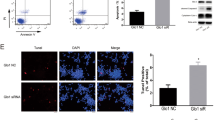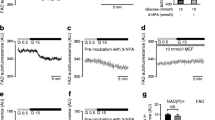Abstract
We have shown previously that genetic or pharmacological deletion of KATP channels protect against beta cell dysfunction induced by reactive oxygen species (ROS). Since it is assumed that glucolipotoxicity (GLTx) causes ROS production, we aimed to evaluate whether suppression of KATP channel activity can also prevent beta cell damage evoked by GLTx. We used an in vitro model of GLTx and measured distinct parameters of stimulus-secretion coupling. GLTx gradually induced disturbances of Ca2+ oscillations over 3 days. This impairment in Ca2+ dynamics was partially reversed in beta cells without functional KATP channels (SUR1−/−) and by the sulfonylurea gliclazide but not by tolbutamide. By contrast, the GLTx-induced suppression of glucose-induced insulin secretion could not be rescued by decreased KATP channel activity pointing to a direct interaction of GLTx with the secretory capacity. Accordingly, GLTx also suppressed KCl-induced insulin secretion. GLTx was not accompanied by decisively increased ROS production or enhanced apoptosis. Insulin content of beta cells was markedly reduced by GLTx, an effect not prevented by gliclazide. Since GLTx markedly diminished the mitochondrial membrane potential and cellular ATP content, lack of ATP is assumed to decrease insulin biosynthesis. The deleterious effect of GLTx is therefore caused by direct interference with the secretory capacity whereby reduction of insulin content is one important parameter. These findings deepen our understanding how GLTx damages beta cells and reveal that GLTx is disconnected from ROS formation, a notion important for targeting beta cells in the treatment of diabetes. Overall, GLTx-induced energy depletion may be a primary step in the cascade of events leading to loss of beta cell function in type-2 diabetes mellitus.








Similar content being viewed by others
Abbreviations
- [Ca2+]c :
-
Cytosolic calcium concentration
- 2-OH-E+ :
-
2-Hydroxyethidium
- DCF:
-
2′,7′-Dichlorofluorescein
- DIV:
-
Days in vitro
- GLTx:
-
Glucolipotoxicity
- ROS:
-
Reactive oxygen species
- SSC:
-
Stimulus-secretion coupling
- T2DM:
-
Type 2 diabetes mellitus
- ΔΨ:
-
Mitochondrial membrane potential
References
Barlow J, Affourtit C (2013) Novel insights into pancreatic beta-cell glucolipotoxicity from real-time functional analysis of mitochondrial energy metabolism in INS-1E insulinoma cells. Biochem J 456(3):417–426. https://doi.org/10.1042/BJ20131002
Bindokas VP, Kuznetsov A, Sreenan S, Polonsky KS, Roe MW, Philipson LH (2003) Visualizing superoxide production in normal and diabetic rat islets of Langerhans. J Biol Chem 278(11):9796–9801. https://doi.org/10.1074/jbc.M206913200
Brun T, Maechler P (2016) Beta-cell mitochondrial carriers and the diabetogenic stress response. Biochim Biophys Acta 1863(10):2540–2549. https://doi.org/10.1016/j.bbamcr.2016.03.012
Cerqueira FM, Chausse B, Baranovski BM, Liesa M, Lewis EC, Shirihai OS, Kowaltowski AJ (2016) Diluted serum from calorie-restricted animals promotes mitochondrial beta-cell adaptations and protect against glucolipotoxicity. FEBS J 283(5):822–833. https://doi.org/10.1111/febs.13632
Drews G, Bauer C, Edalat A, Düfer M, Krippeit-Drews P (2015) Evidence against a Ca(2+)-induced potentiation of dehydrogenase activity in pancreatic beta-cells. Pflugers Arch 467(11):2389–2397. https://doi.org/10.1007/s00424-015-1707-3
Dubois M, Vacher P, Roger B, Huyghe D, Vandewalle B, Kerr-Conte J, Pattou F, Moustaid-Moussa N, Lang J (2007) Glucotoxicity inhibits late steps of insulin exocytosis. Endocrinology 148(4):1605–1614. https://doi.org/10.1210/en.2006-1022
Dufer M, Haspel D, Krippeit-Drews P, Aguilar-Bryan L, Bryan J, Drews G (2004) Oscillations of membrane potential and cytosolic Ca(2+) concentration in SUR1(-/-) beta cells. Diabetologia 47(3):488–498. https://doi.org/10.1007/s00125-004-1348-0
Gier B, Krippeit-Drews P, Sheiko T, Aguilar-Bryan L, Bryan J, Düfer M, Drews G (2009) Suppression of KATP channel activity protects murine pancreatic beta cells against oxidative stress. J Clin Invest 119(11):3246–3256. https://doi.org/10.1172/JCI38817
Gilon P, Arredouani A, Gailly P, Gromada J, Henquin JC (1999) Uptake and release of Ca2+ by the endoplasmic reticulum contribute to the oscillations of the cytosolic Ca2+ concentration triggered by Ca2+ influx in the electrically excitable pancreatic B-cell. J Biol Chem 274(29):20197–20205. https://doi.org/10.1074/jbc.274.29.20197
Grynkiewicz G, Poenie M, Tsien RY (1985) A new generation of Ca2+ indicators with greatly improved fluorescence properties. J Biol Chem 260(6):3440–3450
Harmon JS, Bogdani M, Parazzoli SD, Mak SS, Oseid EA, Berghmans M, Leboeuf RC, Robertson RP (2009) Beta-cell-specific overexpression of glutathione peroxidase preserves intranuclear MafA and reverses diabetes in db/db mice. Endocrinology 150(11):4855–4862. https://doi.org/10.1210/en.2009-0708
Hasnain SZ, Borg DJ, Harcourt BE, Tong H, Sheng YH, Ng CP, Das I, Wang R, Chen AC, Loudovaris T, Kay TW, Thomas HE, Whitehead JP, Forbes JM, Prins JB, McGuckin MA (2014) Glycemic control in diabetes is restored by therapeutic manipulation of cytokines that regulate beta cell stress. Nat Med 20(12):1417–1426. https://doi.org/10.1038/nm.3705
Hasnain SZ, Prins JB, McGuckin MA (2016) Oxidative and endoplasmic reticulum stress in beta-cell dysfunction in diabetes. J Mol Endocrinol 56(2):R33–R54. https://doi.org/10.1530/JME-15-0232
Hu Y, Xu XH, He K, Zhang LL, Wang SK, Pan YQ, He BS, Feng TT, Mao XM (2014) Genome-wide analysis of DNA methylation variations caused by chronic glucolipotoxicity in beta-cells. Exp Clin Endocrinol Diabetes 122(2):71–78. https://doi.org/10.1055/s-0033-1363231
Jayaram B, Syed I, Singh A, Subasinghe W, Kyathanahalli CN, Kowluru A (2011) Isoprenylcysteine carboxyl methyltransferase facilitates glucose-induced Rac1 activation, ROS generation and insulin secretion in INS 832/13 beta-cells. Islets 3(2):48–57. https://doi.org/10.4161/isl.3.2.15016
Kawai J, Ohara-Imaizumi M, Nakamichi Y, Okamura T, Akimoto Y, Matsushima S, Aoyagi K, Kawakami H, Watanabe T, Watada H, Kawamori R, Nagamatsu S (2008) Insulin exocytosis in Goto-Kakizaki rat beta-cells subjected to long-term glinide or sulfonylurea treatment. Biochem J 412(1):93–101. https://doi.org/10.1042/BJ20071282
Kohnke R, Mei J, Park M, York DA, Erlanson-Albertsson C (2007) Fatty acids and glucose in high concentration down-regulates ATP synthase beta-subunit protein expression in INS-1 cells. Nutr Neurosci 10(5-6):273–278. https://doi.org/10.1080/10284150701745910
Kowluru A, Matti A (2012) Hyperactivation of protein phosphatase 2A in models of glucolipotoxicity and diabetes: potential mechanisms and functional consequences. Biochem Pharmacol 84(5):591–597. https://doi.org/10.1016/j.bcp.2012.05.003
Lacraz G, Figeac F, Movassat J, Kassis N, Coulaud J, Galinier A, Leloup C, Bailbe D, Homo-Delarche F, Portha B (2009) Diabetic beta-cells can achieve self-protection against oxidative stress through an adaptive up-regulation of their antioxidant defenses. PLoS One 4(8):e6500. https://doi.org/10.1371/journal.pone.0006500
LeBel CP, Ischiropoulos H, Bondy SC (1992) Evaluation of the probe 2′,7′-dichlorofluorescin as an indicator of reactive oxygen species formation and oxidative stress. Chem Res Toxicol 5(2):227–231. https://doi.org/10.1021/tx00026a012
Lenzen S, Drinkgern J, Tiedge M (1996) Low antioxidant enzyme gene expression in pancreatic islets compared with various other mouse tissues. Free Radic Biol Med 20(3):463–466. https://doi.org/10.1016/0891-5849(96)02051-5
Li N, Stojanovski S, Maechler P (2012) Mitochondrial hormesis in pancreatic beta cells: does uncoupling protein 2 play a role? Oxidative Med Cell Longev 2012:740849
Liesa M, Palacin M, Zorzano A (2009) Mitochondrial dynamics in mammalian health and disease. Physiol Rev 89(3):799–845. https://doi.org/10.1152/physrev.00030.2008
Lim S, Rashid MA, Jang M, Kim Y, Won H, Lee J, Woo JT, Kim YS, Murphy MP, Ali L, Ha J, Kim SS (2011) Mitochondria-targeted antioxidants protect pancreatic beta-cells against oxidative stress and improve insulin secretion in glucotoxicity and glucolipotoxicity. Cell Physiol Biochem 28(5):873–886. https://doi.org/10.1159/000335802
Liu Z, Stanojevic V, Brindamour LJ, Habener JF (2012) GLP1-derived nonapeptide GLP1(28-36)amide protects pancreatic beta-cells from glucolipotoxicity. J Endocrinol 213(2):143–154. https://doi.org/10.1530/JOE-11-0328
Lyon AW, Kisilevsky R (1990) Inhibition of the initiation of hepatic protein synthesis during ethionine mediated ATP depletion in vivo: modification to ribosomal subunits, evidence of impaired ternary complex formation and a subcellular redistribution of eIF-2 alpha. Biochim Biophys Acta 1049(2):158–170. https://doi.org/10.1016/0167-4781(90)90036-2
Marhfour I, Moulin P, Marchandise J, Rahier J, Sempoux C, Guiot Y (2009) Impact of Sur1 gene inactivation on the morphology of mouse pancreatic endocrine tissue. Cell Tissue Res 335(3):505–515. https://doi.org/10.1007/s00441-008-0733-2
Martens GA, Cai Y, Hinke S, Stange G, Van de Casteele M, Pipeleers D (2005) Glucose suppresses superoxide generation in metabolically responsive pancreatic beta cells. J Biol Chem 280(21):20389–20396. https://doi.org/10.1074/jbc.M411869200
Matsunaga T, Li S, Adachi T, Joo E, Gu N, Yamazaki H, Yasuda K, Kondoh T, Tsuda K (2014) Hyperoxia reverses glucotoxicity-induced inhibition of insulin secretion in rat INS-1 beta cells. Biosci Biotechnol Biochem 78(5):843–850. https://doi.org/10.1080/09168451.2014.905175
McLeod LE, Proud CG (2002) ATP depletion increases phosphorylation of elongation factor eEF2 in adult cardiomyocytes independently of inhibition of mTOR signalling. FEBS Lett 531(3):448–452. https://doi.org/10.1016/S0014-5793(02)03582-2
Nagamatsu S, Nakamichi Y, Yamamura C, Matsushima S, Watanabe T, Ozawa S, Furukawa H, Ishida H (1999) Decreased expression of t-SNARE, syntaxin 1, and SNAP-25 in pancreatic beta-cells is involved in impaired insulin secretion from diabetic GK rat islets: restoration of decreased t-SNARE proteins improves impaired insulin secretion. Diabetes 48(12):2367–2373. https://doi.org/10.2337/diabetes.48.12.2367
Newsholme P, Haber EP, Hirabara SM, Rebelato EL, Procopio J, Morgan D, Oliveira-Emilio HC, Carpinelli AR, Curi R (2007) Diabetes associated cell stress and dysfunction: role of mitochondrial and non-mitochondrial ROS production and activity. J Physiol 583(1):9–24. https://doi.org/10.1113/jphysiol.2007.135871
Ostenson CG, Gaisano H, Sheu L, Tibell A, Bartfai T (2006) Impaired gene and protein expression of exocytotic soluble N-ethylmaleimide attachment protein receptor complex proteins in pancreatic islets of type 2 diabetic patients. Diabetes 55(2):435–440. https://doi.org/10.2337/diabetes.55.02.06.db04-1575
Poitout V, Hagman D, Stein R, Artner I, Robertson RP, Harmon JS (2006) Regulation of the insulin gene by glucose and fatty acids. J Nutr 136(4):873–876
Poitout V, Robertson RP (2008) Glucolipotoxicity: fuel excess and beta-cell dysfunction. Endocr Rev 29(3):351–366. https://doi.org/10.1210/er.2007-0023
Prause M, Christensen DP, Billestrup N, Mandrup-Poulsen T (2014) JNK1 protects against glucolipotoxicity-mediated beta-cell apoptosis. PLoS One 9(1):e87067. https://doi.org/10.1371/journal.pone.0087067
Seghers V, Nakazaki M, DeMayo F, Aguilar-Bryan L, Bryan J (2000) Sur1 knockout mice. A model for K(ATP) channel-independent regulation of insulin secretion. J Biol Chem 275(13):9270–9277. https://doi.org/10.1074/jbc.275.13.9270
Somesh BP, Verma MK, Sadasivuni MK, Mammen-Oommen A, Biswas S, Shilpa PC, Reddy AK, Yateesh AN, Pallavi PM, Nethra S, Smitha R, Neelima K, Narayanan U, Jagannath MR (2013) Chronic glucolipotoxic conditions in pancreatic islets impair insulin secretion due to dysregulated calcium dynamics, glucose responsiveness and mitochondrial activity. BMC Cell Biol 14(1):31. https://doi.org/10.1186/1471-2121-14-31
Supale S, Li N, Brun T, Maechler P (2012) Mitochondrial dysfunction in pancreatic beta cells. Trends Endocrinol Metab 23(9):477–487. https://doi.org/10.1016/j.tem.2012.06.002
Zhou L, Cai X, Han X, Ji L (2014) P38 plays an important role in glucolipotoxicity-induced apoptosis in INS-1 cells. J Diabetes Res 2014:834528
Acknowledgements
This work was supported by grants from the Deutsche Forschungsgemeinschaft (GD; Dr225/11-1) and the Brazilian National Council of Technological and Scientific Development (CNPq) (MBO; scholarship number 490162/2013-4).
Author information
Authors and Affiliations
Corresponding author
Ethics declarations
Conflict of interest
The authors declare that they have no conflict of interest.
Ethical approval
All procedures performed in studies involving animals were in accordance with the ethical standards of the institution or practice at which the studies were conducted.
Rights and permissions
About this article
Cite this article
Barroso Oquendo, M., Layer, N., Wagner, R. et al. Energy depletion and not ROS formation is a crucial step of glucolipotoxicity (GLTx) in pancreatic beta cells. Pflugers Arch - Eur J Physiol 470, 537–547 (2018). https://doi.org/10.1007/s00424-017-2094-8
Received:
Accepted:
Published:
Issue Date:
DOI: https://doi.org/10.1007/s00424-017-2094-8




